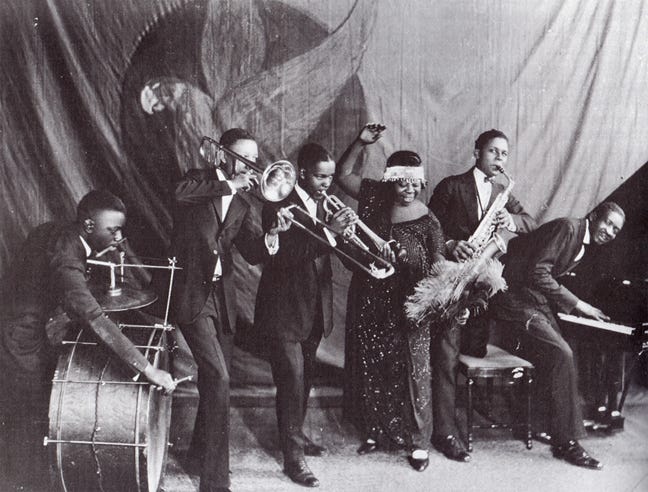Ma Rainey – A Complete Biography
Introduction
Gertrude “Ma” Rainey (born Gertrude Pridgett; April 26, 1886 – December 22, 1939) was one of the earliest and most influential professional blues singers in the United States. Often styled the “Mother of the Blues,” Ma Rainey helped shape the classic female blues tradition of the 1910s and 1920s, brought a theatrical, expressive delivery to rural Southern material, and influenced a generation of later blues and jazz artists. Her stage presence, commanding voice, and sometimes risqué subject matter made her both a commercial star in her era and a lasting cultural icon.

Childhood
Gertrude Pridgett was born in Columbus, Georgia, the daughter of parents who performed in minstrel and vaudeville shows. From a young age she was exposed to performance: family and community entertainment, church singing, and traveling shows formed the backdrop of her early life. She showed musical ability early and took part in local talent shows and black minstrel shows as a girl, learning the conventions of stagecraft that would serve her when she launched her professional career. Her upbringing in the rural and small-town South exposed her to the field hollers, spirituals, and work songs that later informed her blues repertoire.
Youth
As a teenager Gertrude began performing professionally. Around the turn of the 20th century she married Will “Pa” Rainey; the pair performed together and billed themselves on the vaudeville circuit as a comic and musical team. By the 1910s she was touring with traveling tent shows and larger Black touring companies such as Pat Chappelle’s and later the Rabbit’s Foot Company, famed for presenting Black performers to Black and, at times, white audiences. Those years on the road hardened her performance skills: she learned to work a stage, interact with audiences, and blend comedy with deeply felt songs. She also encountered other leading musicians and absorbed a wide range of musical styles while traveling winter circuits through the South and Midwest.
Adulthood
In the 1910s and 1920s Ma Rainey rose to prominence as a headlining attraction on the classic blues circuit. She cultivated an image of flamboyance: elaborate costumes, bold jewelry, and a dramatic stage persona. Between 1923 and 1928 she made her best-known series of recordings for Paramount Records, producing powerful sides that showcased her range, phrasing, and ability to alter a song’s mood. She often blended the theatricality of vaudeville with raw Southern blues feeling, and she frequently wrote or adapted the lyrics she performed—making many of her recordings personal expressions rather than only interpretations of others’ compositions. These records circulated widely on 78 rpm discs and brought her national recognition.
Ma Rainey’s career also intersected with other leading Black musicians. While wintering in New Orleans and touring, she met and worked near figures such as Joe “King” Oliver, and her touring bands and accompanists included notable players who later became important in jazz. She is associated in popular memory and some accounts with Bessie Smith—stories vary about the nature of their relationship, with some saying Rainey mentored Smith; historians debate the details—but there is little doubt that such relationships and rivalries shaped the blues marketplace of the 1920s and helped spread the music’s reach.
Major compositions and recordings
Ma Rainey’s recorded legacy is concentrated in her Paramount sessions of the mid-1920s. Some of her most enduring sides include “See See Rider Blues,” “Bo-Weevil Blues,” “Moonshine Blues,” and “Ma Rainey’s Black Bottom.” These recordings show her dramatic phrasing, use of repetition and call-and-response patterns, and an ability to move between humor, sorrow, and sexual frankness. Unlike many performers of her era, Rainey wrote or co-wrote a substantial portion of what she recorded; researchers have noted that a significant fraction of her recorded repertoire reflects her own authored or arranged material. Her songs became standards covered by later blues and rock artists. The emotional directness and performance theatricality she employed were central to the classic female blues idiom and helped shape later developments in American popular music.
Death
After a long performing career that spanned vaudeville circuits and the early recording industry, Ma Rainey retired in the 1930s. She died on December 22, 1939, in Columbus, Georgia. Despite her fame in the 1920s, like many Black performers of the era she did not always receive lasting financial security from her recordings. Nevertheless, her recorded legacy and the influence she exerted on later singers ensured her place in the history of American music.
Conclusion
Ma Rainey’s life and work sit at a pivotal point in American music: she was trained in the older theatrical and minstrel-based touring traditions, but she helped define the language of the blues that would be carried forward by later performers in jazz, rhythm & blues, and rock. Her combination of theatrical command, songwriting, and unapologetic depiction of Black women’s lives left an indelible mark on the music and culture of the United States. Interest in her life has persisted into the 21st century, rekindled by scholarly work, reissues of her recordings, and cultural portrayals that point to her role as an artist who pushed boundaries on stage, in her lyrics, and in her public persona.

Comments are closed